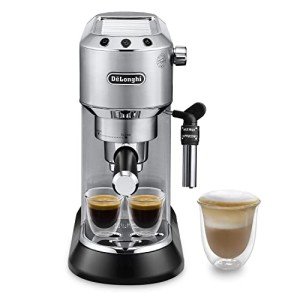This Is How Home Espresso Machines Will Look Like In 10 Years' Time
The Rise of Home Espresso Machines: A Comprehensive Guide
As coffee fans continue to seek fresh and delicious brews at home, the appeal of home espresso machines has risen over the last few years. No longer simply the domain of coffee shops and coffee bar, these machines empower individuals to craft barista-quality espresso beverages from the convenience of their kitchen areas. Visit Web Page will check out the numerous types of home espresso machines, their functions, and factors to consider for picking the right one. Additionally, it will offer a selection of FAQs to help prospective purchasers make informed choices.
Types of Home Espresso Machines
Home espresso machines can be categorized into several classifications based upon their systems and user-friendliness. Each type has its distinct features, pros, and cons.
Type
Description
Pros
Cons
Manual Espresso Machines
Requires the user to by hand manage the brewing procedure, involving techniques like pulling a lever to produce pressure.
- Complete control over developing procedure
- Compact style
- Requires ability and practice
- Time-consuming
Semi-Automatic Machines
Machine automates water circulation and pressure, however the user still manages the dosing and duration of the brewing procedure.
- Balance of automation and control
- Versatile
- Learning curve for improving techniques
Completely Automatic Machines
Automates the entire developing procedure, from grinding to brewing, typically with programmable settings for tailored drinks.
- Extremely easy to use
- Quick and convenient
- Less control over the developing process
- Higher price point
Capsule or Pod Machines
Utilizes pre-packaged espresso pills or pods to create coffee rapidly and quickly.
- Extremely easy to use
- Minimal clean-up
- Limited taste variety
- More pricey per cup than ground coffee
Super-Automatic Machines
Combines features of completely automatic machines with built-in grinders, enabling users to brew entire bean espresso and milk-based drinks with one touch.
- All-in-one convenience
- Ideal for milk-based drinks
- Often the most expensive
- Can be bulky
Features to Consider
When selecting a home espresso machine, possible purchasers need to think about the following functions to ensure they pick a machine that meets their needs:
Grinder Type:
- Built-in mills can offer fresher premises but may need more upkeep.
- Different mills permit more customization of grind size.
Pressure:
- Look for machines that produce at least 9 bars of pressure, which is optimum for brewing espresso.
Water Temperature Control:
- Machines with adjustable temperature settings permit better extraction of taste from beans.
Milk Frothing Options:
- Consider whether you desire a manual steam wand for frothing or an automatic milk frother for convenience.
Ease of Cleaning:
- Machines with detachable parts and self-cleaning functions substantially decrease cleanup time.
Size and Design:
- Ensure the machine fits comfortably in your cooking area and lines up with your aesthetic preferences.
Budget:
- Set a budget before beginning your search, as rates can vary significantly from affordable models to high-end machines.
Advantages of Home Espresso Machines
Owning a home espresso machine offers many advantages:
- Cost-Effective: Over time, brewing espresso in the house can save coffee enthusiasts money compared to frequent café check outs.
- Personalization: Users can experiment with different beans, grind sizes, and developing strategies to find their ideal cup.
- Convenience: The ability to brew espresso whenever removes the need to go out to a café, especially beneficial throughout late nights or early mornings.
- Quality Control: With a home machine, individuals have complete control over the quality of active ingredients and brewing processes.
Disadvantages of Home Espresso Machines
However, there are some disadvantages to think about:
- Initial Investment: High-quality espresso machines can be pricey, requiring a substantial in advance investment.
- Knowing Curve: Mastering the art of espresso developing can take time and practice, which might be frightening for newbies.
- Upkeep: Like any device, espresso machines require routine cleaning and upkeep to make sure optimal efficiency.
Frequently asked questions
1. What is the best type of home espresso machine for novices?
Response: For beginners, a semi-automatic machine is often advised as it uses a balance in between control and automation, permitting you to find out the basics without overwhelming intricacy.
2. Just how much should I invest in a home espresso machine?
Response: Entry-level machines can begin around ₤ 100 to ₤ 300, while higher-end designs can vary from ₤ 500 to over ₤ 2000. It's important to set a budget based upon your anticipated use and desired functions.
3. Do I need a different grinder?
Answer: While some espresso machines feature built-in grinders, buying a separate grinder allows for greater personalization and ensures better quality premises.
4. How frequently should I clean my espresso machine?
Answer: Cleaning frequency can vary by machine type, however it's typically recommended to clean the machine after each use and carry out deep cleanings weekly or month-to-month, depending upon use.
5. Can I make milk-based drinks with any espresso machine?
Response: Not all machines feature milk frothing abilities. If you enjoy beverages like lattes or coffees, search for a machine with a steam wand or automatic frother.
Home espresso machines are changing the way coffee enthusiasts enjoy their precious brews. With numerous types and advanced features offered in the market, there is something for everyone. Whether it's the delight of developing special recipes or simply appreciating the perfect shot of espresso, purchasing a home espresso machine can enhance both the coffee-drinking experience and the lifestyle for coffee lovers everywhere. As with any financial investment, it is important to weigh the advantages versus the potential downsides and select a machine that seamlessly fits both your way of life and preferences.
